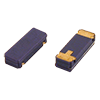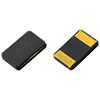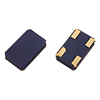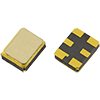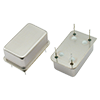Signal Integrity Considerations in High-Frequency Design with Frequency Control Products
24 Nov 2023
KATIEJENKIN@GOLLEDGE.COM
This article dives into the critical facets of signal integrity (SI) in high-frequency designs and the central role that frequency control products play in maintaining it.
In the fast-paced world of electronics, the effectiveness of high-frequency systems lies significantly in the integrity of their signals. Given this, maintaining superior SI is paramount for accurate, dependable data transmission.
High-frequency design poses many challenges such as noise interference, signal attenuation, and impedance issues that could seriously undermine SI. Frequency control products, including quartz crystals , oscillators, and filters, are pivotal in mitigating these challenges. They work to maintain the stability of signal frequency, reduce noise, control impedance, and limit signal attenuation, thereby ensuring excellent SI.
Throughout the remainder of this article, we will aim to provide a comprehensive understanding of this intricate subject matter. We will pay particular attention to the leading frequency control products offered by us here at Golledge Electronics , demonstrating how we can help you to maintain the integrity of signals in complex high-frequency systems.
The Impact of Frequency Control on Signal Integrity
In high-frequency design, frequency control products serve a crucial function. They ensure that the signal maintains its frequency and shape, preserving the integrity of the transmitted information.
By offering stability and accuracy, frequency control products act as the foundation for optimal signal performance, controlling issues such as jitter, phase noise, and harmonic distortion which can concern for signal integrity.
Frequency control products like oscillators and quartz crystals work by providing a stable timing reference or 'clock'. This 'clock' helps regulate and synchronise the operations within a device, significantly improving electrical signal strength, data accuracy, and overall system reliability.
AS the UK's leading supplier of Frequency Control Products, Golledge provides real-world solutions to poor signal integrity challenges. One example is our range of high-stability oscillators used in GPS systems. These oscillators are pivotal in maintaining a precise timing reference, ensuring the accuracy of location data.
Similarly, our high-quality quartz crystals are employed in telecommunications, offering the frequency stability required for clear, high-speed data transfer.
These examples illustrate the profound impact frequency control products can have on signal integrity, underlining their importance in high-frequency design.
Key Considerations for Noise Reduction in High-Frequency Design
Noise in electronic systems, specifically high-frequency designs, can profoundly affect signal integrity. Unwanted disturbances or 'noise' can disrupt the accuracy of signal transmission, leading to data loss and overall system unreliability. In high-frequency systems, common sources of noise include:
- Power supply fluctuations
- Thermal noise
- Crosstalk.
Strategies for noise reduction in high-frequency designs often revolve around meticulous design practices, such as:
- Employing shielding techniques
- Improving power supply stability
- Ensuring adequate spacing between high-speed traces to prevent crosstalk.
Additionally, grounding techniques, like the use of ground planes, can minimise noise impact.
When it comes to specific frequency control products that can assist in this noise reduction process, the top ones to look out for are:
- Quartz crystals: Ensure a stable and accurate signal frequency,
- Oscillators: Help to minimise jitter and phase noise
- SAW filters: Used to suppress unwanted frequencies
Through meticulous design and the implementation of high-quality frequency control products , significant noise reduction in high-frequency designs can be achieved, thereby preserving signal integrity.
Discover how to purchase class-leading frequency control products from Golledge to ensure your next project is a success.
Impedance Matching Techniques for Good Signal Integrity
Impedance matching is an important idea in electronics. Impedance refers to resistance to the flow of electric current. When an electrical source, like a battery or generator, is connected to a load, like a light bulb or speaker, the source has a certain impedance, and the load also has an impedance.
If the impedance of the source does not match the impedance of the load, it can reduce the efficiency of power transfer. The electricity may be reflected back from the load towards the source, rather than being fully absorbed by the load.
Impedance matching means making the impedance of the source equal to the impedance of the load. This allows the maximum amount of power to be transferred from the source to the load. It ensures the source "sees" an impedance that matches its own, so power flows efficiently into the load.
Accurate matching minimises signal reflection, allowing maximum power transfer from the source to the load, thus preserving signal integrity.
In high-frequency design, maintaining correct impedance is critical due to the speed at which signals are transferred. Any impedance mismatches can cause signal reflections, leading to signal distortion, power loss, and ultimately, degradation of signal integrity.
Achieving optimal impedance matching in high-frequency designs often involves the use of frequency control products. For instance, oscillators from Golledge Electronics are designed to work at specific impedance levels, ensuring maximum power transfer and minimal signal reflection.
Designers can also employ techniques like using impedance-controlled PCB materials , utilising termination resistors, or tuning the source or load impedance with reactive elements to achieve optimal impedance matching.
In summary, maintaining correct impedance through the use of frequency control products and design techniques is pivotal to maintaining optimal signal integrity in high-frequency designs.
Future Trends in Signal Integrity and Frequency Control Integration
The world of electronics is ever-evolving, and so too are the trends and technologies related to signal integrity and frequency control.
As we look towards the future, there is a growing need for even greater precision and speed in electronic systems. This translates into an increased focus on signal integrity within high-frequency designs, with more stringent requirements for noise reduction, impedance matching, and signal stability.
One notable trend is the adoption of artificial intelligence (AI) in electronic design automation (EDA). This is likely to significantly impact the strategies used to maintain signal integrity in high-frequency designs. Advanced machine learning algorithms can help optimise design processes, predict severe signal integrity problems, and suggest appropriate remedies more accurately and quickly than before.
Additionally, we are seeing the rise of high-speed digital technologies, including 5G and beyond, Internet of Things (IoT) , and advanced radar systems. These technologies operate at unprecedented frequencies and bandwidths, introducing new challenges in terms of signal integrity.
Adapting to these trends, Golledge Electronics is continually refining its range of frequency control products. We are investing in R&D to develop advanced solutions that can meet the requirements of these emerging technologies. For instance, we are working on new high-frequency, low-jitter oscillators and highly stable quartz crystals, designed to keep pace with increasing system complexities and frequencies.
With a firm eye on the future, Golledge is dedicated to providing high-quality, innovative solutions that meet and exceed our customers' requirements, today and tomorrow.
Get in touch with our team to ensure your signal Integrity is optimal for your next application or project.
Signal integrity FAQS
Signal integrity is a critical aspect of high-frequency electronic design, ensuring that signals transmitted within a system remain intact and free from distortion or degradation. Here are some frequently asked questions about signal integrity:
1. What is signal integrity in electronics?
Signal integrity refers to the ability of a signal to retain its quality as it travels through a circuit or transmission medium. It encompasses factors such as:
- signal distortion
- attenuation
- noise
- timing
- jitter
All of these can impact the accuracy and reliability of data transmission in electronic systems, especially at high frequencies.
2. What is the signal integrity method?
The signal integrity method involves various techniques aimed at maintaining signal quality and integrity throughout the design and implementation of electronic circuits. This includes careful consideration of factors such as:
- transmission line impedance matching
- controlled impedance routing
- signal termination
- electromagnetic interference (EMI) mitigation strategies
3. What is the basic signal integrity?
At its core, basic signal integrity involves ensuring that signals propagate within a circuit or transmission medium without distortion or degradation. Thereby, preserving their original characteristics. This includes minimising signal reflections, controlling impedance mismatches, and managing parasitic effects that can affect signal quality.
4. What is signal integrity engineering?
Signal integrity engineering is the discipline concerned with the analysis, design, and optimisation of electronic systems to ensure reliable signal transmission and reception. It encompasses a range of activities, including simulation and modeling of signal behaviour, characterisation of transmission lines and components, and the application of mitigation techniques to address signal integrity issues.

